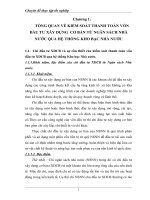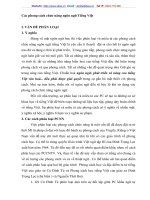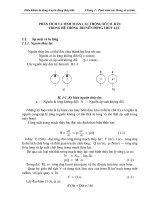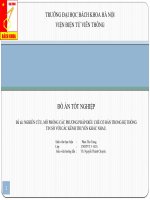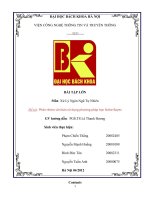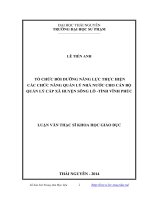Thực hiện các chức năng ngôn ngữ tiếng Anh để dạy tiếng Anh cơ bản trong hệ thống Đại học Thái Nguyên
Bạn đang xem bản rút gọn của tài liệu. Xem và tải ngay bản đầy đủ của tài liệu tại đây (9.16 MB, 171 trang )
THAI NGUYEN UNIVERSITY
Socialist Republic of Vietnam
BATANGAS STATE UNIVERSITY
Republic of the Philippines
PURSUING THE ENGLISH LANGUAGE FUNCTIONS
IN TEACHING THE BASIC ENGLISH COURSE AT
THAI NGUYEN UNIVERSITY (TNU) SYSTEM
A Dissertation
Presented to
The Faculty of Graduate School
Batangas State University
Batangas City, Philippines
In Partial Fulfillment
Of the Requirements for the Degree
Doctor of Philosophy
Major in English
By:
LUU THI HUONG (JULIA)
December 2014
i
THAI NGUYEN UNIVERSITY
Socialist Republic of Vietnam
BATANGAS STATE UNIVERSITY
Republic of the Philippines
TABLE OF CONTENTS
TITLE PAGE
CHAPTER I 5
THE PROBLEM 5
Introduction 5
Statement of the Problem 12
Scope, Delimitation and Limitation 13
Significance of the Study 14
REVIEW OF LITERATURE 17
Conceptual Literature 17
Research Literature 33
Synthesis 39
Theoretical Framework 43
Conceptual Framework 46
Hypothesis 48
Definition of Terms 48
RESEARCH METHOD 51
Research Design 51
Subjects of the Study 52
Data Gathering Instrument 53
Data Gathering Procedure 54
Statistical Treatment of Data 56
PRESENTATION, ANALYSIS AND INTERPRETATION OF DATA 57
SUMMARY, CONCLUSION AND RECOMMENDATION 88
Summary 88
Findings 90
Conclusion 99
Recommendations 101
BIBLIOGRAPHY 102
APPENDICES 109
CURRICULUMN VITAE 159
i
THAI NGUYEN UNIVERSITY
Socialist Republic of Vietnam
BATANGAS STATE UNIVERSITY
Republic of the Philippines
LIST OF TABLES
Table Title Page
Table 1 53
Distribution of Sample Respondents 53
Table 2 58
Teachers’ Respondents Awareness of the Seven Functions of the English
language 58
Table 3 59
Seven Functions of the English Language according to the 59
Degree of Importance 59
Table 4 62
Frequency of Students’ Use Based on the seven functions of English
language in Reading 62
Table 5 65
Frequency of Students’ Use based on the seven functions of English
language in Writing 65
Table 6 68
Level of students reading performance in the seven functions of language. .68
Table 7 69
Level of students writing performance in the seven functions of language 69
Table 8 71
Student's Language Performance in Reading and Writing 71
Teaching the Basic English Course based on the seven functions of language
in Reading 73
Table 9(b) 73
ii
THAI NGUYEN UNIVERSITY
Socialist Republic of Vietnam
BATANGAS STATE UNIVERSITY
Republic of the Philippines
Teaching the Basic English Course based on the seven functions of language
in Writing 73
Table 10 (a) 74
Frequency of Students’ Use based on seven functions of English language. 74
Table 10 (b) 75
List of seven functions of the English language in reading and writing and
their frequency of use according to the respondents 75
Table 11(a) 77
Degree of Importance in Reading based on seven functions of language 77
Table 11(b) 77
Degree of Importance in Writing based on seven functions of language 77
Table 12 79
Comparison of the Assessment of Teachers and Students’ Performance in
Reading and Writing 79
Table 13 81
Bases in the design of functional activities for students and teachers 81
LIST OF FIGURES
iii
THAI NGUYEN UNIVERSITY
Socialist Republic of Vietnam
BATANGAS STATE UNIVERSITY
Republic of the Philippines
iv
THAI NGUYEN UNIVERSITY
Socialist Republic of Vietnam
BATANGAS STATE UNIVERSITY
Republic of the Philippines
CHAPTER I
THE PROBLEM
Introduction
The increasing use of the English language globally has had a large
impact on many other languages, leading to language shift and even language
death,
and to claims of linguistic imperialism. English itself has become more
open to language shift as multiple regional varieties feed back into the language
as a whole.
English is a global language. People hear it on television by
politicians from all over the world and whenever people travel, they see
English sign and advertisement. A language achieves a genuinely global
status when it develops a special role that is recognized in every country.
These points add to the complexity of the present day world
situation, but they do not alter the fundamental point. Because of the three
pronged development of first language, second language, and foreign
language speakers, it is inevitable that a global language will eventually
come to be used by more people than any other language. English has
already reached this stage.
English is the dominant business language and it has become
almost a necessity for people to speak English if they are to enter a global
5
THAI NGUYEN UNIVERSITY
Socialist Republic of Vietnam
BATANGAS STATE UNIVERSITY
Republic of the Philippines
workforce. Research from all over the world shows that cross-border
business communication is most often conducted in English. Its importance
in the global market place therefore cannot be understated, learning
English really can change people’s life.
During the last decades, the world has witnessed lots of cultural,
social, political, economical and technological changes. In this new, global
world, people have had to meet the needs brought about by these changes
in order to keep up with them. One of the most important needs is
language learning. By the help of the developments in technology and
science, people all over the world have to communicate with people from
other countries, which require the learning of different foreign languages.
The most commonly used language in the world is English. In fact English
is known as a key to open the door into bustling world of rapid changes
and development. Everyday an increasing number of people are trying to
learn English for different purposes with the hope that they can use it
effectively.
One of the main goals of language teachers is to provide students
with the tools to be effective communicators in the teaching language.
Often when students are assigned projects and assignments their lack of
practical tools to produce the actual language becomes evident. In these
cases, students might very well have the necessary resources to
6
THAI NGUYEN UNIVERSITY
Socialist Republic of Vietnam
BATANGAS STATE UNIVERSITY
Republic of the Philippines
accomplish the task, but teachers might need to consider a communicative
approach to teaching the language, focusing on the functions of language,
to properly equip students to complete assigned tasks. Those functions are
namely: Instrumental showing the way an individual satisfies the need by
asking for something like “May I use your phone?”; Regulatory stating
controlling another’s behavior such as the teacher requests students “stand
up!”; Interactional used for maintaining interpersonal like wishing a friend a
merry Christmas; Personal is considered as where one talks about oneself
“I feel so happy today”; Heuristic is used to find out the world in general, for
example: “is there any solution for environment pollution?”; Imaginative
focuses on where one talks about one’s imagination like telling stories and
jokes; Representational refers to seeking and giving varied types of
information like “ How many survivors were there in the terrorism in France
last week?”.
Many people believe it’s important to have knowledge on the
functions of language for specific purposes. Whether they are apologizing,
expressing a wish or asking permission, they use language in order to fulfill
that purpose. Each purpose can be known as a language function.
Savignon (1983) describes a language function as the use to which
language is put, the purpose of an utterance rather than the particular
grammatical form an utterance takes. By using this idea to structure
7
THAI NGUYEN UNIVERSITY
Socialist Republic of Vietnam
BATANGAS STATE UNIVERSITY
Republic of the Philippines
teaching, the instructional focus becomes less about form and more about
the meaning of an utterance. In this way, students use the language in
order to fulfill a specific purpose, therefore making their speech more
meaningful.
The basic communication goals can be expressed in terms of
situations, functions and topics. It is up to the teacher to plan the situations
within which students will be able to use their language for a purpose in the
classroom context. By creating a situation the teacher is providing the
necessary context students need to use the language for a function.
Language functions have two categories: micro functions which refer
to the specific individual use and macro functions which serve more overall
aims according to Finch (1998). Micro functions consist of seven functions
such as physiological function in terms of releasing physical and nervous
energy, phatic function for sociability, recording function, identifying
function, reasoning function, communicating function, and pleasure
function. Macro functions refer to the ideational function, interpersonal
function, poetic function, and textual function.
In the study of language, it is of significant importance that students
develop their language skills. These language skills are vital tools for
complete communication. These are reading, writing, listening and
speaking.
8
THAI NGUYEN UNIVERSITY
Socialist Republic of Vietnam
BATANGAS STATE UNIVERSITY
Republic of the Philippines
Writing is one among the basic skills in learning a language. It is
both social and cognitive process. Students view writing as a necessity.
They are aware that this can improve thinking as well. Students find
writing as most difficult among the language skills because of its
complexity. Their writing skill is one way to know their academic success or
performance and it is also a basic requirement to participate in any
endeavor in their personal life as well as in the global economy.
The basic level of writing required by colleges or universities for
incoming students who want to study is not met since there are large
number of adolescent graduates from high school who are not equipped
with the basic literacy skills needed like lacking the ability to write to meet
the growing demands of the college curriculum. Students who have poor
writing skills are also referred to as low performing writer. They are those
students whose writing skills do not meet the adequate demands of the
class.
Writing difficulties like all other learning problems can be frustrating
on the part of the students’ education and self -esteem. A student who has
problem in writing would experience interference in his learning. He is
unmotivated and lacks enthusiasm to write because of his inadequacy of
the skill.
9
THAI NGUYEN UNIVERSITY
Socialist Republic of Vietnam
BATANGAS STATE UNIVERSITY
Republic of the Philippines
Problems that confront teachers regarding students’ problems in
writing are focused on what students will write and how to motivate them to
write about interesting topic. If students do not have the proper or right
perspective, writing for them becomes a boring act. So that teachers look
for a way to combine other skills in teaching for students to have freedom
to meaningfully express them.
Reading as a language skill helps students expand their knowledge
in large messages or paragraphs. It is one of the most important skills that
a person can acquire. It helps the learner to understand the world by
enabling them to learn about the past and plan for the future. For academic
success, reading is important since it is also considered a critical skill. In
the educational system reading is well integrated that either educational or
academic success is considered synonymous to reading success.
Reading is the key that unlocks the door in the world of enjoyment.
Reading is perhaps the most important language skill to develop in all
learners, requiring a multi-faceted process. Therefore, reading should
become indispensable to learner because if they don’t learn reading
especially from the beginning, they would surely find difficulty in learning
other skills.
Students do not become good readers due to the following reasons:
poor ability or for making insufficient effort, unsuitable course books, which
10
THAI NGUYEN UNIVERSITY
Socialist Republic of Vietnam
BATANGAS STATE UNIVERSITY
Republic of the Philippines
do not encourage them to read and do not raise their interest of reading,
wrong attitude of the teachers and students about the subject,
inappropriate teaching methods and classroom techniques.
Reading difficulties become most apparent when the reader is
unable to grasp the meaning from a text passage. Reading may be
affected by the difficulties of the text, the vocabulary of the words used in
the text, and the reader’s familiarity with the subject matter, among other
factors. Moreover, reading difficulties have been caused by inadequate
instruction, insufficient exposure and practice, deficient word recognition
skills, deficient memory capacity and functioning, significant language
deficiencies, inadequate comprehension monitoring and self-evaluation,
unfamiliarity with text features and task demands, undeveloped attentive
strategies and inadequate cognitive development and reading experiences.
In the process of integration and development in international
economic relations of Vietnam nowadays, one of the decisive factors
relating to the society’s economic development of the Nation is to extent
the foreign economy, in which learning a foreign language is one of the
most important contents to contribute that process. It is really necessary for
Vietnamese people to learn foreign languages in general as well as English
in particular when Vietnam country enters to integrate the world economy,
especially Vietnam becomes an official member of WTO. Cited from the
11
THAI NGUYEN UNIVERSITY
Socialist Republic of Vietnam
BATANGAS STATE UNIVERSITY
Republic of the Philippines
Resolution adopted by the tenth Party Congress, Vietnam is planning to try
to become a country where its people could speak English as a second
language like the Philippines today in 2020.
In April 2009, the Ex - Prime Minister of Singapore, Mr. Ly Quang
Dieu visited Vietnam and had a very sincere advice to Vietnamese that
Vietnam should train English for unemployed people in order to reduce the
rate of the poor. The demand of using English in universities, colleges,
banks, restaurants and offices is quickly increasing, so teaching English as
a global language is very significant and effective.
With this scenario, as an English Language teacher of Thai Nguyen
University handling Basic English course, the researcher become
interested to look into the writing and reading performance of First Year
College students in the seven functions of language and come up with
enrichment activities gearing towards enhancement of writing and reading
performance.
Statement of the Problem
This study aimed to determine the reading and writing performance
of first year college students taking up Basic English course in the seven
functions of language at Thai Nguyen University (TNU) System during the
12
THAI NGUYEN UNIVERSITY
Socialist Republic of Vietnam
BATANGAS STATE UNIVERSITY
Republic of the Philippines
Academic Year 2013-2014 with the end view of proposing functional
enrichment activities.
Specifically, it sought answers to the following questions:
1. How are the Basic English course in the seven language functions
being carried out in the beginning College English course in terms of:
1.1. awareness
1.2. degree of importance,
1.3. teaching reading; and
1.4. teaching writing?
2. What is the level of students’ reading performance? relative to:
2.1. Instrumental
2.2. Regulatory
2.3. Interactional
2.4. Personal
2.5. Heuristic
2.6. Imaginative
2.7. Representational
3. What is the level of students’ writing performance in the seven functions
of language?
4. Are there significant differences between reading and writing
performance of students?
5. How do the teachers assess the reading and writing performance of
students based on the seven functions of language?
6. How do the assessment of teachers and performance of students in
reading and writing compare?
7. What functional enrichment activities in the English language may be
proposed?
Scope, Delimitation and Limitation
13
THAI NGUYEN UNIVERSITY
Socialist Republic of Vietnam
BATANGAS STATE UNIVERSITY
Republic of the Philippines
This study focused on determining the first year college students’
reading and writing performance in the seven functions of language in the
Basic English Course at Thai Nguyen University (TNU) System, Vietnam.
The study dealt about the student’s writing and reading performance in
terms of instrumental, regulatory, interactional, personal, heuristic,
imaginative and representational language functions as well as the
teachers’ assessments on the said language functions. The output of the
study is in the form of functional enrichment activities to improve students’
weaknesses on Basic English Course along these language functions.
The study covered the four (4) Thai Nguyen Universities in Thai
Nguyen City and used 53 teachers teaching Basic English course and
1,266 First Year College students who were presently enrolled in the
Academic Year 2013-2014. Students who were not enrolled in the Basic
English course as well as those in the higher levels were not included in
the study. Results of the study were limited on the information from the
respondents in the Academic year 2013-2014.
Significance of the Study
The study was deemed beneficial to the Administrators of Thai
Nguyen University, English teachers, First Year students, Parents and
Future researchers.
14
THAI NGUYEN UNIVERSITY
Socialist Republic of Vietnam
BATANGAS STATE UNIVERSITY
Republic of the Philippines
Administrators. Results of the study will guide them in the
curriculum development by evaluating the different English proficiency
enhancing activities. These will also serve as a guide for the realignment
of the existing curriculum of Basic English to meet their institutional goals
and objectives.
Faculty of Basic English. Results of this study will make the
faculty, teaching Basic English aware of the student’s performance in
writing and speaking. These will provide them insights on what classroom
learning activities would be appropriate to enhance the language
proficiency of their students. Likewise, the teachers might propose some
enrichment activities to improve the student’s writing and reading
performance.
First Year Students. Findings of this study will make them aware of
their present performance in writing and reading. These will give them a
challenge to improve their weak points and enhance their over-all
performance in Basic English.
Parents. Through this study, parents of the first year students will
become aware of the English performance of their children which will make
them more supportive and cooperative in school activities specifically on
the improvement of the skills in the Basic English of their children.
15
THAI NGUYEN UNIVERSITY
Socialist Republic of Vietnam
BATANGAS STATE UNIVERSITY
Republic of the Philippines
Future researchers. Results of this study will serve as reference for
their undertaking.
16
THAI NGUYEN UNIVERSITY
Socialist Republic of Vietnam
BATANGAS STATE UNIVERSITY
Republic of the Philippines
CHAPTER II
REVIEW OF LITERATURE
This chapter presents the review of conceptual and research
literature which provides the right direction to complete the research study,
synthesis, theoretical framework, conceptual framework, hypothesis and
definition of terms.
Conceptual Literature
The concepts reviewed serves as the basis of the study. It included
the following: teaching the English language to beginners, English
language functions, evaluation of reading and writing performance, and
English language enrichment activities.
Teaching the English Language to Beginners. English as an
international language and the most widely used in the world today is used
in international meetings and conferences. It is also the language used in
education. Many non-English speakers study the language since learning
the language would open doors to many opportunities and success.
Teaching the English language to beginners is not an easy task.
Numerous problems are encountered from students ranging from
mispronunciation of words, wrong spelling, incorrect grammar, and lack of
17
THAI NGUYEN UNIVERSITY
Socialist Republic of Vietnam
BATANGAS STATE UNIVERSITY
Republic of the Philippines
confidence. So, that there are suggestions or tips on how teachers can
teach English to beginners. Myers (2014) shared her methodology on
teaching English to absolute beginners. These include making sentences
out of words on cards and letting students memorize and repeat short
dialogues. In teaching students, vocabulary should be the focus instead of
grammar especially for production. It is suggested that walls in the
classroom should be covered with useful familiar language. Likewise, the
teacher must use direct method of teaching using mime, gestures, visual
aids and wall charts.
Bleyer (2012) on the other hand emphasized that in teaching Basic
English to beginners teacher must speak slowly and clearly and makes
sure that beginner students understand her lessons. Students’ names and
nicknames must be remembered by teacher and students as well as the
place where they live as these will serve as basis to practice Basic English
structures. Basic things such as sounds of the alphabet, spelling, reading
rules and Basic English grammar structures should be the starting point for
teaching.
In teaching English to beginners, teachers must remember not to
overwhelm students with new materials; show students that lessons can be
fun, they can participate in the activities and perform well (busy teacher
.org/3773 –how-to-teach-english-to-beginners.html). In designing the
18
THAI NGUYEN UNIVERSITY
Socialist Republic of Vietnam
BATANGAS STATE UNIVERSITY
Republic of the Philippines
curriculum, teachers must bear in mind the following: for lesson material, it
is important to go slowly in introducing information to students until they are
comfortable with what they covered; for teacher talking in the classroom, it
should be slowed down as students will never understand if it is done
rapidly and for drill exercises teacher must enunciate clearly and talk loudly
for the entire class to hear. As for practice, teacher must choose practice
that are simple, easy to understand and easy to explain. Demonstration is
the best option as using lots of words may confuse students. As they
improve, more complex activities may be introduced. For having fun,
students must be given opportunity to learn in a different way through
language studies as the goal of every language teacher is to let students
communicate with her and others in a positive creative environment.
Andrews (2005) on the other hand provided tips for teaching ESL
beginners and pre-literate adults. These are making sure personal
connection comes first; use interruptions as teaching moments that trump
whatever lesson the teacher planned; try to minimize; feed students’
stomachs sometimes, not just their minds; try to meet students half way;
communicate slowly, clearly and directly; and avoid books that are too
childish.
In addition, the following are suggested in teaching English for
beginners: smiling helps as it is something that can be understood on a
19
THAI NGUYEN UNIVERSITY
Socialist Republic of Vietnam
BATANGAS STATE UNIVERSITY
Republic of the Philippines
universal level especially in building rapport with the students and support
capacity; finding an assistant as it creates a great atmosphere in the class
where students help each other in the learning process and makes things
easier; use of realia such as flash cards and other visuals; knowing of few
basic words and phrases in the students’ language; speaking slowly;
teaching of all four skills; repeating commands; and chill, relax, be calm,
and avoiding stress as well as building a strong rapport with students (busy
teacher, org/ 4793-top -8- tips –on- teaching- absolute- beginners. html).
English Language Functions. Language is a system of arbitrary
symbols used by members of a society to communicate with one another
as defined by Clifford Praetor, head of the Second Language Teaching
Department of the University of California. It is a system of rules,
unconsciously present in the mind, that enables humans to relate sounds
and meanings (Delahunty et al, 1994). Language is a means by which
sounds and meanings are related. There is some sound symbolism in
language, that is , there are words whose pronunciation suggests the
meaning (Fromkin et al, 1974). If one has the knowledge about language
words to form phrases, phrases to form sentences can be combined. This
is because knowing a language means being able to produce new
sentences never spoken before and to understand sentences never heard
20
THAI NGUYEN UNIVERSITY
Socialist Republic of Vietnam
BATANGAS STATE UNIVERSITY
Republic of the Philippines
before. This ability according to Chomsky (1972) is referred to as the
creative aspect of language.
Halliday (1975) stated that language is systemic because it is
paradigmatically organized which means any piece of language on any
scale can be described as the output of a system of choices and that as
the child moves into the mother tongue, language functions give way to the
generalized meta-functions of language. In this process, in between the
two levels of the proto language system, an additional content is inserted.
Instead of one level of content, there are now two: the lexico-grammar and
semantics.
Function refers to systemic and non- systemic linguistics. There are
three particular types of functions in systemic linguistics and these are
micro-function which makes use of constituents like subject, actor, or
theme; macro-function which deals with the language used in early child-
language such as functions of imagination, discovery, interaction and
others and meta-function which is the generalized functional principle of
linguistic organization. Meta-functions comprised of three types namely:
the ideational, the interpersonal and the textual.
According to Blor et al (1995) these three functions operate
simultaneously in the expression of meaning. In ideational function leaner’s
experience is expressed where elements of the external word and that of
21
THAI NGUYEN UNIVERSITY
Socialist Republic of Vietnam
BATANGAS STATE UNIVERSITY
Republic of the Philippines
consciousness are expressed. The two sub-functions in the field of
parameters of register which are reflected in ideational function are the
experienced and the logical. The experiential functions concern with
content or ideas with the system of transitivity as the outcome. The
following are the six process types of transitivity systems: material, mental,
relational, behavioral, verbal and existential. Logical function is concerned
with the relationships between ideas.
Functions are expressions of feeling and attitude that do not typically
correspond to grammatical categories. Wilkins (1976 ) pointed out that
these categories could provide a clear rationale, from the standpoint of
learner requirements, for selecting the language to which the learner will be
exposed and which the learner will be supposed to acquire. Functions of
language promotes the constructive interaction between linguistics and
such neighboring disciplines as sociology, cultural studies, psychology,
ethnology, communication studies, translation theory and educational
linguistics (Mackenzie, 2008).
According to Halliday (1978) the seven functions of language is
referred to as the functional view of language where the interest lies on
what the language can do, or in what the speaker, child or adult can do
with it. These language functions are instrumental, regulatory, interactional,
personal, imaginative, heuristic, and presentational. This functional account
22
THAI NGUYEN UNIVERSITY
Socialist Republic of Vietnam
BATANGAS STATE UNIVERSITY
Republic of the Philippines
of language used support the communicative language teaching linguistic
theory.
The language used by children to satisfy needs and desires, and to
make requests, or the language used by older children to persuade is
referred to as instrumental function of language which is transmitted when
the buying and ordering situations is dramatized by students and is being
captured in letters of order and invitation of students.
Furthermore, Christodoulou (2009) stated that instrumental function
of language is language used to fulfill a need on the part of the speaker
which is directly concerned with obtaining food, drink and comfort.
Instrumental function of language can also be understood by using
language to get things. However, regulatory function of language, is used
to control the behavior of others to do what one wants such as instructing
and demonstrating and when writing list of directions or memos and
classroom rules.
Interactional language function on the other hand is used to establish
and define social relationship. Mohr et al (2007) explained that
interactional language is the language used to build and maintain
relationship. It can be compared to transactional language, which normally
carries a message and is the language used to get things done. Learners
in a multi-lingual group, chatting together before a class begins are using
23
THAI NGUYEN UNIVERSITY
Socialist Republic of Vietnam
BATANGAS STATE UNIVERSITY
Republic of the Philippines
interactional language. Teachers can present elements of interactional
language, and raise learners’ awareness of interaction language by
exposure to video and authentic conversation. Learner can learn to use
paralinguistic features such as gesture, eye contact, and body language,
and linguistic features to maintain an interactional conversation including
functions such as expressing interest and asking for clarification.
The language used to express feelings, opinions, and individuality is
covered in personal language. Sharing personal background and in talking
about one’s stance on an issue are some areas where this language is
manifested and this can best be reflected in the students’ autobiographical
essay. Creating a world of one’s own, and expressing fantasy through
drama, poetry and stories are avenues where imaginative language can be
used.
The ability to use and appreciate language as a creative medium is
reflected in imaginative language. It is based on a model where an
environment is created to a child through sounds, stories, make-believe,
poetry and creative writing. The rubric of this language function allows
learner to play with the target language the use of puns, rhyme,
alliteration, and other poetic and literary devices. Creating and considering
possibilities are the principal purpose of imaginative function.
24
